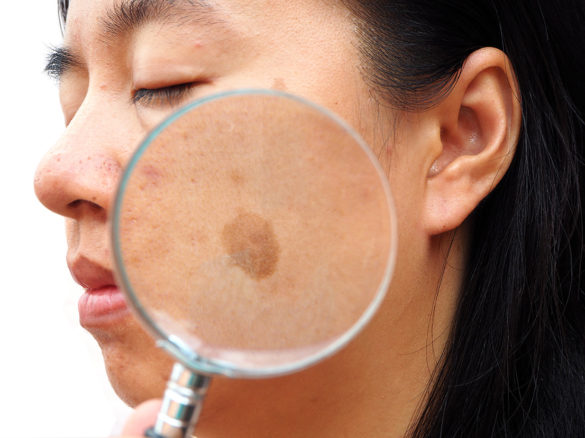Melasma (pigmentation) is a common skin condition in adults that mainly affects the face.
It is more common in women and people with darker skin. Whilst sun exposure generally makes it more pronounced, there is no allergy behind it, it is not a sign of sun damage and it does not increase your risk of skin cancer.
 It is not really known what causes Melasma, but there are several internal and external elements that play a role.
It is not really known what causes Melasma, but there are several internal and external elements that play a role.
The most common of these is sun exposure and tanning beds. Sometimes pregnancy can temporarily bring it on (it is often called chloasma in pregnancy). Similarly, the contraceptive pill and very occasionally medical conditions affecting hormone levels can induce Melasma. Less commonly, perfumed cosmetics are found to be a cause. Some patients report that other family members have been affected and there is therefore a genetic tendency to its development. In most people, there is no identifiable cause.
Melasma is generally present for a reasonable length of time without harm or symptoms before it is brought to attention. The face, neck and sometimes the forearms tend to be affected. It is easily recognised by most doctors as areas of darker skin that are otherwise flat and normal.
There are a number of ways in which the skin colour can be brought towards normal and certain precautions can help keep it normal. There is, however, no known treatment to remove the tendency to darkening in people who suffer from Melasma.
If a definite trigger is identified, such as the contraceptive pill or a perfumed cosmetic, then removal will generally result in the pigment resolving. If the appearance of the skin condition is associated with pregnancy, it often improves after delivery.
In other circumstances, skin lightening creams (such as hydroquinone, azelaic acid and retinoid creams) over some months produce a good result for most people. These are generally only available on prescription and there are some caveats to their use so discussion with a skin specialist is advised.
Skin affected by Melasma darkens more than the surrounding skin with exposure to sunlight. Sun avoidance and sun protection are therefore important. Broad-spectrum fragrance-free sunscreens, with a sun protection factor (SPF) of 30 or greater and a high ultraviolet A (UVA) star-rating, should be applied daily throughout the year, and broad-brimmed hats are recommended. In particular, avoidance and protection measures should be employed during the period of most intense sunshine (between 11.00 am and 3.00 pm). Sunbeds should not be used.
What can I do?
- Sun protection with the appropriate sun screen and clothing is by far the most important action you can take. Continued sun protection is important to maintain the improvement in your Melasma, even after treatment.
- Make sure that your sun screen has UVB and the right UVA protection. While UVB helps protect against burning, it is the UVA protection that helps to slow down re-pigmentation.
- If you have acquired a bleaching cream, be careful with overuse as this can cause permanent changes in pigmentation.
I heard a rumour…
…that lasers can cure Melasma
Laser treatment can produce improvement. There is more than one type of laser used and each works by a slightly different mechanism. Unfortunately, results are not consistent and there are some reports of pigment worsening, excessive lightening and scarring. The experience of the laser operator is a key factor.
…that chemical peels and dermabrasion are good for pigmentation
The excess pigment in Melasma resides in the upper most layer of skin. Chemical peels/dermabrasion remove this layer. The experience of the operator is, however, an important factor. Worsening of the pigmentation, scarring and excessive de-pigmentation are potential side effects.
…that cosmetic camouflage is expensive
Cosmetic camouflage is a special make-up which is matched to the skin colour of the individual and will not easily come off. Your GP or dermatologist may refer you to somebody with beautician experience to assist you in finding the right product and to teach you how to apply it.


